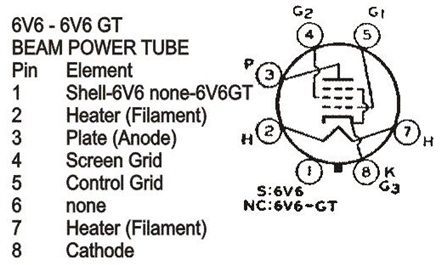|
Electric Guitar Tubes

Vacuum tubes have been around since the late 1800's and continue on in electric guitar tubes used in amplifiers. A vacuum tube in it's simplest form has an anode or plate, a cathode, and a heating element, which are all placed inside a vacuum container usually made of glass. The tube works by first having the heating element, or filament, warm up the cathode which provides electrons in the vacuum. The electrons are then attracted to the cathode, which is negatively charged. When a current is applied, electrons travel from the cathode to the anode. Some of the first tubes took advantage of this one way travel, and became the first rectifiers, converting alternating current to direct current. Rectifier tubes are still used in guitar amplifiers today, such as the Fender Deluxe Reverb. In the early 20th century it was discovered that a tube could be used as an amplifier. By placing a grid between the cathode and anode, then applying a small signal to the grid, the tube would regulate the amount of electron flow between the cathode and anode, proportional to the signal strength to the grid. This in effect allowed a small signal to be "amplified" and is how electric guitar amps work today. As time went on it was discovered that the triode, for reasons beyond my knowledge base, could be improved by adding a second grid called a screen, this tube became known as the Tetrode. After the tetrode it was found that adding a second screen proved advantages and thus became the Pentode. Eight Pin Tetrodes, like the 6L6, and pentodes like the EL34 are the primary power tube used in electric guitar tube amplifiers today. However some amps enable the screens to be lowered, and have the power tube act as a triode. Such as in some of the blackheart amplifiers. The main preamp tube used today is the 9 pin 12AX7 which is a dual triode tube. Many folks get confused when looking at an amp schematic, because it looks like there are two tubes, when there is only one. Electric Guitar Tubes will continue to be important for electric guitarists until solid state amps can compare in warmth, and tube distortion characteristics. J.B. 3-12-11
return from Electric Guitar Tubes to Electric Guitar Info home |
If you have any questions regarding electric guitar modifications, building, setup, amplifiers, etc. send me an email .....Guitarinfo145@aol.com..... All questions are appreciated, and often lead to new ideas for additional content. I do my best to get back as soon as possible, Thanks, J.B.




